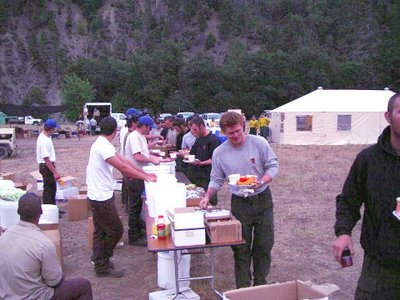The meal is usually cooked in the mobile kitchen, which can be located 10 to 20 miles from the spike camp. Breakfast and the sack lunch are transported to the spike camp early in the morning. Dinner will be delivered in the evening as the crews are returning from the fire.
These photos are from the InciWeb.com website for the Bar Complex Wildland Fire, which is located in the Shasta-Trinity National Forest in Northern California.
 Fire crews eat breakfast at Denny spike camp. Hot food is brought to the camp in the white 5-gallon buckets, or "hot cans." Meals served out of hot cans must be served within a four-hour window. The buckets aren't designed to hold hot or cold food for long periods of time.
Fire crews eat breakfast at Denny spike camp. Hot food is brought to the camp in the white 5-gallon buckets, or "hot cans." Meals served out of hot cans must be served within a four-hour window. The buckets aren't designed to hold hot or cold food for long periods of time.
Many menu items are purchased in pre-portioned packages. Since there is little refrigeration at a spike camp, leftover food must be consumed or discarded.
This meal line is reminiscent of meals my cooks delivered to Seabees working in the field during my 20 years in Naval Construction Force units. Although we don't use the term spike camp in the Seabees, the idea is the same.
Photo credit: Paul Slenkamp of the Alaska Division of Forestry.
 Fire crews returning to the Denny spike camp in the evening after a day on the fire line. This camp is located in a large dry meadow.
Fire crews returning to the Denny spike camp in the evening after a day on the fire line. This camp is located in a large dry meadow.
Fire crews are often "spiked" in locations much closer to the fire line. It's more efficient to bring meals and supplies to the firefighters than to transport then from and to the base camp each morning and evening. Spike camps are often relocated every two or more days as the fire line changes.
Photo credit: Mike Johnson of the National Park Service.


No comments:
Post a Comment